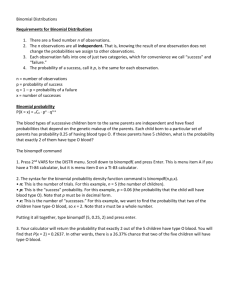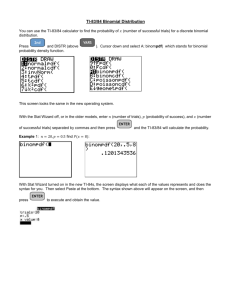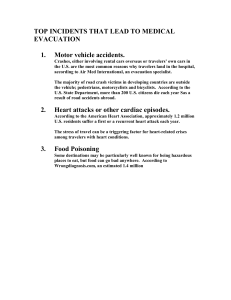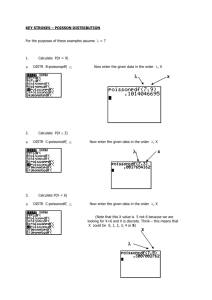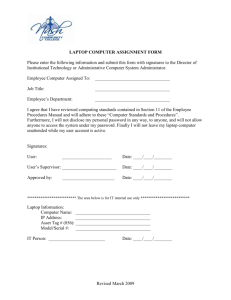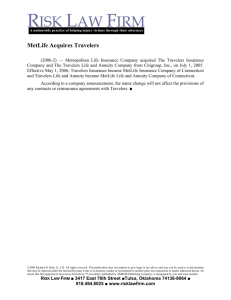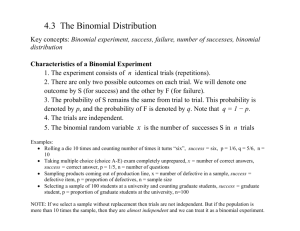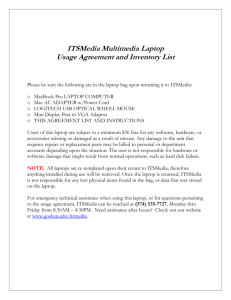Calculator Helps
advertisement
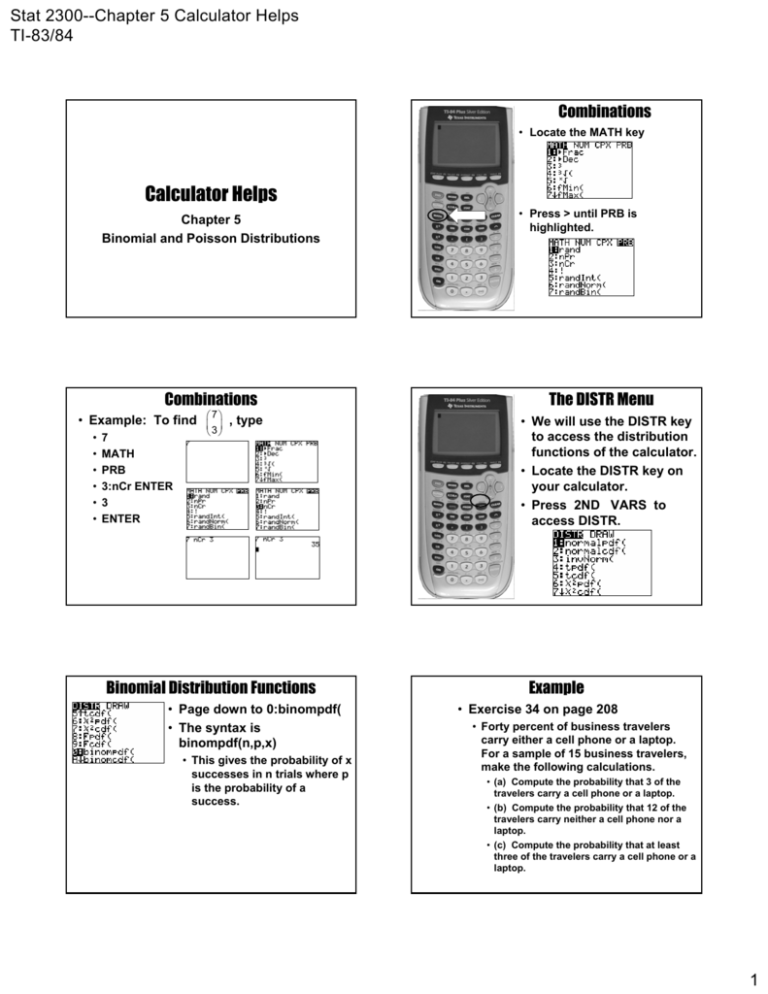
Stat 2300--Chapter 5 Calculator Helps TI-83/84 Combinations • Locate the MATH key Calculator Helps Chapter 5 Binomial and Poisson Distributions Combinations • Example: To find • • • • • • 7 MATH PRB 3:nCr ENTER 3 ENTER ⎛7⎞ ⎜3⎟ ⎝ ⎠ , type Binomial Distribution Functions • Page down to 0:binompdf( • The syntax is binompdf(n,p,x) • This gives the probability of x successes in n trials where p is the probability of a success. • Press > until PRB is highlighted. The DISTR Menu • We will use the DISTR key to access the distribution functions of the calculator. • Locate the DISTR key on your calculator. • Press 2ND VARS to access DISTR. Example • Exercise 34 on page 208 • Forty percent of business travelers carry either a cell phone or a laptop. For a sample of 15 business travelers, make the following calculations. • (a) Compute the probability that 3 of the travelers carry a cell phone or a laptop. • (b) Compute the probability that 12 of the travelers carry neither a cell phone nor a laptop. • (c) Compute the probability that at least three of the travelers carry a cell phone or a laptop. 1 Stat 2300--Chapter 5 Calculator Helps TI-83/84 Part (a) • Here, n=15, p=.40, and x=3. • Type • • • • • • • • • DISTR 0:binompdf( 15 , (the comma is above the number 7) .4 , 3 ) (the final parenthesis is optional) ENTER Note that this rounds to .0634, which is the number on the binomial table on page 942. Part (b) • This part of the problem is asking about the opposite event, travelers who carry neither a cell phone nor a laptop. • The probability of “success” in this part is 1.40=.60 • So, n=15, p=.6, and x=12. • Note that this is the same answer we get in part (a). Why is that? (Hint: If exactly 12 travelers have neither a cell phone nor a laptop, what must the other 3 have?) Part (c) • Compute the probability that at least three of the travelers carry a cell phone or a laptop. • “At least three” means three or more. The easiest way to calculate this is to find the probability of getting 2 or fewer and subtract it from 1. • In mathematical notation: • P(at least 3) = 1 – P(2 or fewer) • = 1 – [f(0) + f(1) + f(2)] • The binomcdf function lets us compute f(0) + f(1) + f(2) all at once. It is called a cumulative density function. Poisson Distributions • Exercise 41 on page 212 says: • During the period of time that a local university takes phone-in registrations, calls come in at the rate of one every two minutes. • (a) What is the expected number of calls in one hour? • (b) What is the probability of three calls in five minutes? • (c) What is the probability of no calls in a five-minute period? Part (c), continued • Choose A:binomcdf( • Syntax is binomcdf(n,p,x) • This gives the probability of x or fewer successes in n trials with probability of success p. • Enter binomcdf(15, .4, 2) • Subtract this result from 1. • There is a .9729 probability that at least 3 travelers carry a cell or a laptop. Part (b) • We need to find the expected number of calls in 5 minutes. ⎛ 1call ⎞ ⎜ ⎟ × ( 5min ) = 2.5calls = μ ⎝ 2min ⎠ • Use B:poissonpdf( • Part (a) does not require a probability density function. ⎛ 1 call ⎞ ⎛ 60min ⎞ 30 calls ⎜ 2min ⎟ × ⎜ 1 hour ⎟ = hour ⎝ ⎠ ⎝ ⎠ • Syntax is poissonpdf(µ, x) 2 Stat 2300--Chapter 5 Calculator Helps TI-83/84 Part (b), continued • Type • • • • • • DISTR B:poissonpdf( 2.5 , 3 ) • The probability of 3 calls in 5 minutes is .2138. Part (c) • Here we want the probability of no calls in 5 minutes. Again, µ=2.5 and now x=0. • The probability is .0821. • Note: the poissoncdf function can be used in a similar manner to the binomcdf function. 3
